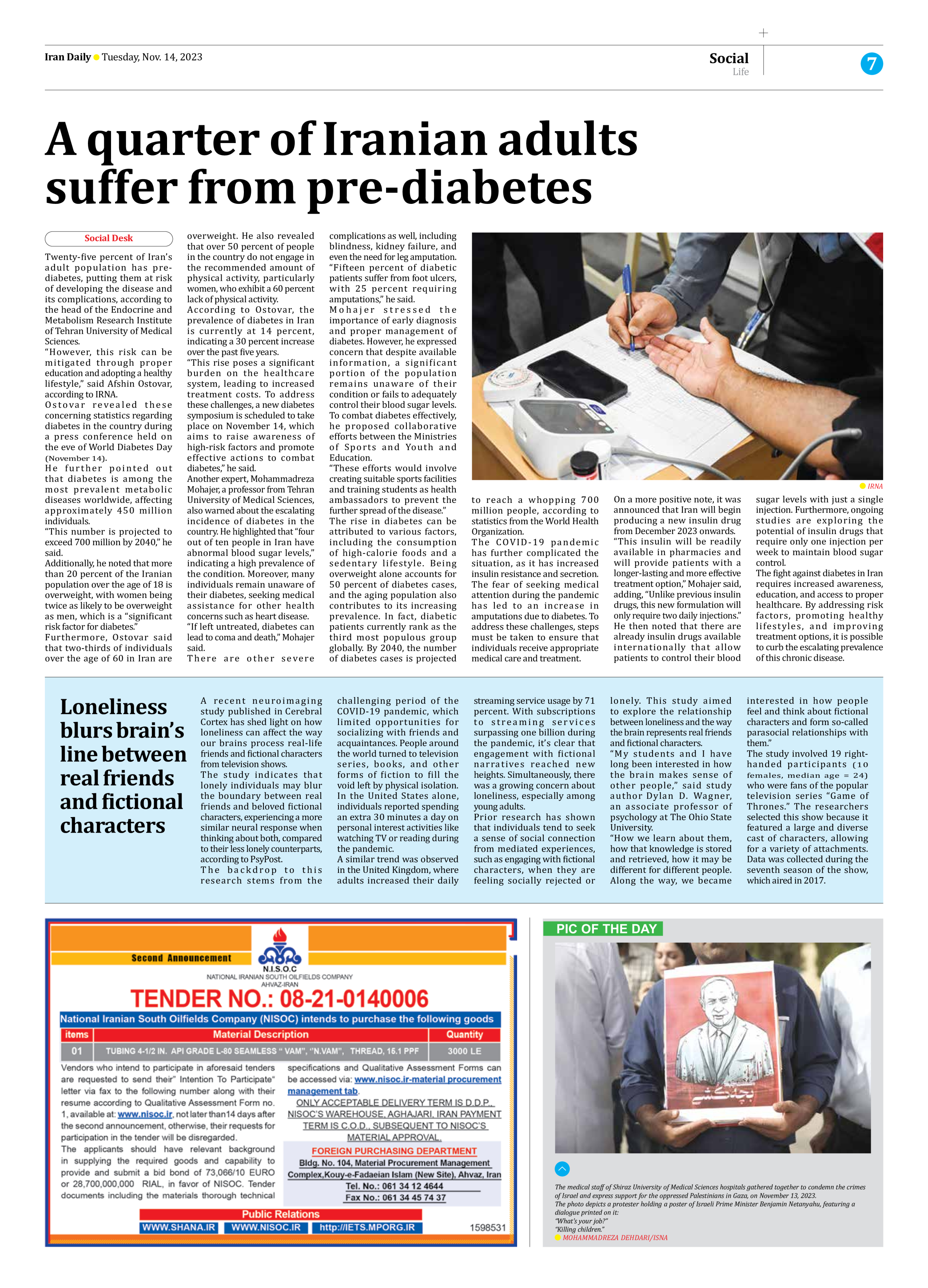
A quarter of Iranian adults suffer from pre-diabetes
Twenty-five percent of Iran’s adult population has pre-diabetes, putting them at risk of developing the disease and its complications, according to the head of the Endocrine and Metabolism Research Institute of Tehran University of Medical Sciences.
“However, this risk can be mitigated through proper education and adopting a healthy lifestyle,” said Afshin Ostovar, according to IRNA.
Ostovar revealed these concerning statistics regarding diabetes in the country during a press conference held on the eve of World Diabetes Day (November 14).
He further pointed out that diabetes is among the most prevalent metabolic diseases worldwide, affecting approximately 450 million individuals.
“This number is projected to exceed 700 million by 2040,” he said.
Additionally, he noted that more than 20 percent of the Iranian population over the age of 18 is overweight, with women being twice as likely to be overweight as men, which is a “significant risk factor for diabetes.”
Furthermore, Ostovar said that two-thirds of individuals over the age of 60 in Iran are overweight. He also revealed that over 50 percent of people in the country do not engage in the recommended amount of physical activity, particularly women, who exhibit a 60 percent lack of physical activity.
According to Ostovar, the prevalence of diabetes in Iran is currently at 14 percent, indicating a 30 percent increase over the past five years.
“This rise poses a significant burden on the healthcare system, leading to increased treatment costs. To address these challenges, a new diabetes symposium is scheduled to take place on November 14, which aims to raise awareness of high-risk factors and promote effective actions to combat diabetes,” he said.
Another expert, Mohammadreza Mohajer, a professor from Tehran University of Medical Sciences, also warned about the escalating incidence of diabetes in the country. He highlighted that “four out of ten people in Iran have abnormal blood sugar levels,” indicating a high prevalence of the condition. Moreover, many individuals remain unaware of their diabetes, seeking medical assistance for other health concerns such as heart disease.
“If left untreated, diabetes can lead to coma and death,” Mohajer said.
There are other severe complications as well, including blindness, kidney failure, and even the need for leg amputation.
“Fifteen percent of diabetic patients suffer from foot ulcers, with 25 percent requiring amputations,” he said.
Mohajer stressed the importance of early diagnosis and proper management of diabetes. However, he expressed concern that despite available information, a significant portion of the population remains unaware of their condition or fails to adequately control their blood sugar levels. To combat diabetes effectively, he proposed collaborative efforts between the Ministries of Sports and Youth and Education.
“These efforts would involve creating suitable sports facilities and training students as health ambassadors to prevent the further spread of the disease.”
The rise in diabetes can be attributed to various factors, including the consumption of high-calorie foods and a sedentary lifestyle. Being overweight alone accounts for 50 percent of diabetes cases, and the aging population also contributes to its increasing prevalence. In fact, diabetic patients currently rank as the third most populous group globally. By 2040, the number of diabetes cases is projected to reach a whopping 700 million people, according to statistics from the World Health Organization.
The COVID-19 pandemic has further complicated the situation, as it has increased insulin resistance and secretion. The fear of seeking medical attention during the pandemic has led to an increase in amputations due to diabetes. To address these challenges, steps must be taken to ensure that individuals receive appropriate medical care and treatment.
On a more positive note, it was announced that Iran will begin producing a new insulin drug from December 2023 onwards.
“This insulin will be readily available in pharmacies and will provide patients with a longer-lasting and more effective treatment option,” Mohajer said, adding, “Unlike previous insulin drugs, this new formulation will only require two daily injections.”
He then noted that there are already insulin drugs available internationally that allow patients to control their blood sugar levels with just a single injection. Furthermore, ongoing studies are exploring the potential of insulin drugs that require only one injection per week to maintain blood sugar control.
The fight against diabetes in Iran requires increased awareness, education, and access to proper healthcare. By addressing risk factors, promoting healthy lifestyles, and improving treatment options, it is possible to curb the escalating prevalence of this chronic disease.







